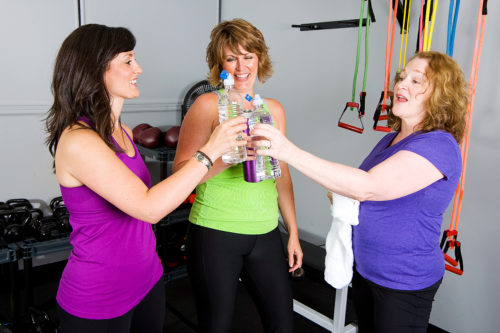Healthy Aging

Take care of your body. It’s the only place you have to live.
-Jim Rohn
Working in acute care for over 20 years I’ve been on the care-giving end of many elderly patients; most them being women who tend to live longest. For many women longevity can be a mixed blessing; while women do live longer than men (on average 5 yrs.), they are at greater risk of an old age tempered with a disability.
Aging with Chronic Disease
Many of our disease states, especially in the elderly, have gone from acute, such as pneumonia (the “old man’s friend”) which killed the patient in 2 weeks–to chronic; not cured but managed over long periods of time. We tend to see acute exacerbation of chronic conditions such as congestive heart failure, diabetes, or COPD, repeatedly. The diseases that drastically shortened life-spans in the past are now the cause of multiple hospitalizations and caregiver-burnout. In theparlance of medical-slang, we called them “frequent flyers” and they get to be wellknownby staff as they come in for periodic”tune-ups.”
When do Women’s Chronic Conditions Start?
Researchers at Duke University Medical School found that obesity and arthritis begin for women in the child-bearing and peri-menopausal years caused by weight gain. In addition, the study showed the women were more likely than men to experience fractures, vision problems, and bronchitis. “Women have a natural tendency to gain more weight than men over the lifespan but may be more motivated to maintain a healthy weight if they realize that those extra pounds make it more likely that they will be disabled in later years – potentially becoming a burden to their children or requiring a nursing home. This is important because it suggests that women’s tendency to pack on extra pounds in their child-bearing and peri-menopausal years translates into a loss of independence in their old age.”
– Heather Whitson, M.D.(Assistant Professor of Medicine)
Women’s Chronic Diseases Translates to Loss of Independence
Who ends up in skilled care facilities? According to the U.S. Bureau of the Census, slightly over 5 percent of the 65+ population are in nursing homes, assisted living, and congregate housing; and rates increase with age from 1.4% of the youngest-old to 24.5% of the oldest-old. It’s usually women due to:
- Longevity: Women invariably represent a high percentage of the oldest old. For example, in the United States in 2000, some 67% of those above age 80 were women; among centenarians, women accounted for 87% of the total
- Spend Down: Lifetime savings is used up by caring for husbands in old age
- Lack of Informal Care: Care provided by non-paid family members
“Most elderly males have informal care, most elderly females do not.”
–Cynthia M. Taeuber
I often heard patients express that they don’t want to be a burden to their children. An Aging-in-Place in America study found many elders fear nursing homes over dying; that being the case, making the future a part of one’s current philosophyis likesocial self-defense for women planning on aging-in-place.
Hanging on at Home
I read an article online from SmartMoney titled; Hanging on at Home. The piece begins with the jugular question: Where will people live as they grow old?
The author goes on to describe a summary of the social forces that have shaped the living conditions of seniors prior to WWII, up to the present. He then provides five suggestions for “cutting through the clutter” of aging-in-place information on the web. Not too cloudy the waters further, but I’d like to add a sixth suggestion…
Jack Was Right
Many of the targeted audience for the SmartMoney article grew up watching black and white images of a sincere, high-energy-buffed-guy in a tight-fitting jumpsuit, giving motivational chats, leading invigorating workouts, encouraging deep breathing and healthy living; all accompanied by lively organ music.
The sets were simple (a steel office chair and a poster board) but the concepts were not–and they still ring true today.
Jack Lalanne was right; he knew that many people’s lives were just suicide on the installment plan. Jack recognized if you don’t take the time to be healthy–you’ll have to take the time to be sick.
Functional Aging
Aging in place requires more than just making a few simple changes such as replacing doorknobs with pull handles or installing ramps and no-step thresholds. These strategies are important, but functional aging is a key element in extending independence.
Lalanne described “functional aging” in his The Hands of Time episode. The goal was to die “young,” as late in life as possible…which is really the difference between extending life vs. extending health–they are not the same thing.
Much attention has been paid lately to the biomarkers of aging and how they can be affected by lifestyle. One key biomarker (measurable physiological factor related to aging) is aerobic capacity. Aerobic capacity (age and weight specific) is how exercise physiologist measure uptake and utilization of oxygen by the body; the term used is VO2max. This is an essential factor for aging in place because if you have a VO2max of less than 10ml/kg/min you can’t live independently at home because of the inability to do activities of daily living(ADLs).
The Bad News
As we age, under normal conditions (meaning no underlying diseases like lung cancer) our VO2max after age 30 decreases by 1% each year. So, a 70-year-old has a 40% decrease in VO2max.
The Good News
Exercise can decrease that 1% yearly decline in VO2max after age 30, by half. So, a 70-year-old may only experience a 20% decrease in VO2max.
The Sixth Suggestion
So, while you’re doing that elder-friendly home evaluation, embracing the concept of universal design, emphasizing fall prevention, comparison shopping-remodelers, and staying aware of public trends…PLEASE don’t overlook taking care of yourself physically (and mentally). As Jack might have said; Your Biography becomes your Biology, how you live will determine, in large part, how you age. The time to start is now…
